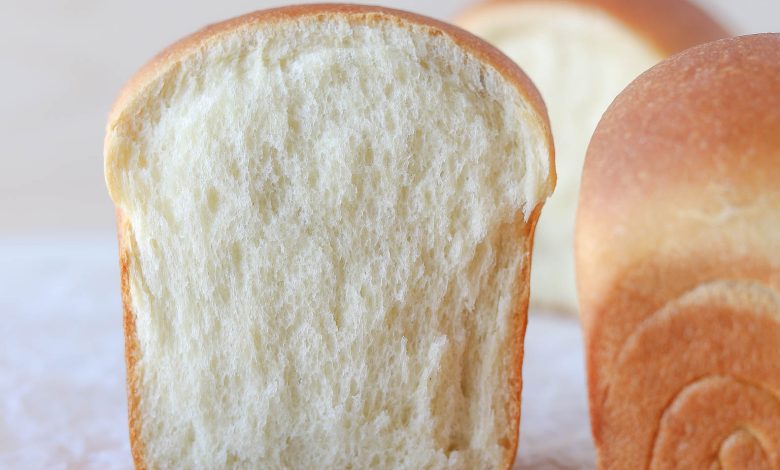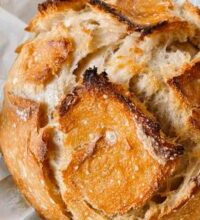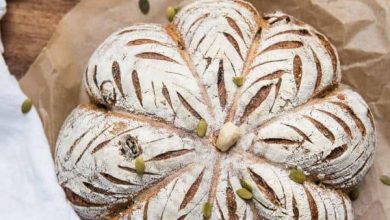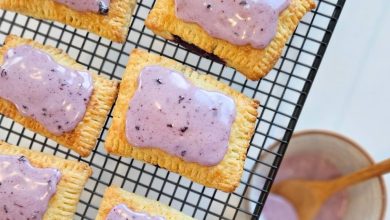
Introduction
Sourdough milk bread is a soft and fluffy type of bread that combines the gentle flavor of milk with the mild tang of sourdough. It is a recipe that makes your home smell warm and comforting while baking. The texture is pillowy and rich, making it perfect for sandwiches, toast, or even as a simple snack with butter and jam. Unlike regular bread, sourdough milk bread has a natural fermentation process that gives it a unique flavor and makes it easier to digest. When you take your first bite, you can feel how soft it is, how slightly sweet the flavor is, and how it melts in your mouth.
People love this recipe because it brings together two beautiful worlds. It has the lightness and sweetness of milk bread, and the natural tang and health benefits of sourdough. Every slice feels soft and comforting, reminding you of bakery-style bread but made in your own kitchen. It is also a fun way to use your sourdough starter and turn it into something that everyone in the family will enjoy. This bread goes beautifully with morning tea, coffee, or even soups and salads.
You can make sourdough milk bread when you want something cozy, homemade, and satisfying. It is perfect for weekends when you have time to relax and enjoy baking. It is also a great choice for people who care about healthy eating because sourdough is easier to digest and often has less gluten effect. The fermentation process breaks down the starches and makes the bread lighter on your stomach. Baking this bread can also be an emotional joy. The moment you knead the dough and see it rise slowly, it feels like magic happening in your kitchen. The smell of fresh sourdough milk bread can instantly lift your mood and make your home feel warm and peaceful.
Ingredients You Will Need
To make this beautiful sourdough milk bread, you will need some simple and fresh ingredients that you probably already have at home. Make sure to measure them correctly for the best results.
-
120 grams of active sourdough starter (fed and bubbly)
-
450 grams of bread flour (or all-purpose flour if you prefer a softer texture)
-
50 grams of sugar
-
250 milliliters of whole milk (lukewarm)
-
50 grams of unsalted butter (softened)
-
1 teaspoon of salt
-
1 egg (for the dough)
-
1 egg yolk (for brushing on top before baking)
-
1 tablespoon of water (to mix with egg yolk for brushing)
Optional ingredients for extra flavor:
-
1 tablespoon of honey for a sweet taste
-
1 teaspoon of milk powder for a richer texture
-
1 teaspoon of vanilla essence if you like a hint of flavor
Step by Step Method
Making sourdough milk bread is not difficult if you follow each step carefully. It takes a little patience, but the result is worth it.
Step 1: Prepare your sourdough starter
Before you start making the dough, make sure your sourdough starter is active and bubbly. Feed it about 4 to 6 hours before you plan to start baking. It should double in size and have small bubbles on top. This shows it is ready to help your bread rise naturally.
Step 2: Warm the milk
Pour the milk into a small pot and warm it slightly until it feels just warm to the touch, not hot. If it becomes too hot, let it cool down for a few minutes. Warm milk helps activate the starter and makes the dough softer.
Step 3: Mix the ingredients
In a large mixing bowl, add the warm milk, sugar, egg, and sourdough starter. Whisk them together until well mixed. Then slowly add the flour and salt. Mix until the dough starts to come together. You can use your hands or a stand mixer with a dough hook.
Step 4: Add butter and knead
Once the dough forms, add the softened butter a little at a time. Keep kneading until all the butter is absorbed into the dough. This process might take around 10 to 15 minutes by hand or about 8 minutes in a mixer. The dough should feel smooth, elastic, and slightly sticky but not too wet.
Step 5: First rise (bulk fermentation)
Shape the dough into a ball and place it in a lightly greased bowl. Cover it with a damp cloth or plastic wrap. Let it rest at room temperature for about 4 to 6 hours. Depending on your room temperature, it might take longer. The dough should increase in size by about 50 percent.
Step 6: Cold fermentation (optional but recommended)
For a better flavor and easier shaping, place the dough in the refrigerator overnight for slow fermentation. This helps the bread develop a deeper sourdough taste and improves the texture.
Step 7: Shaping the dough
Take the dough out of the refrigerator and let it come to room temperature for about one hour. Gently press it down to remove extra air bubbles. Divide the dough into three equal parts. Roll each piece into a rectangle, then fold the sides in and roll it up like a log. Place the three rolls side by side in a greased loaf pan.
Step 8: Final proof
Cover the loaf pan with a damp towel and let the dough rise again until it doubles in size. This may take 3 to 5 hours depending on the temperature of your kitchen. When you lightly touch the dough with your finger, it should slowly spring back, which means it is ready to bake.
Step 9: Prepare for baking
Preheat your oven to 180 degrees Celsius (about 350 degrees Fahrenheit). Mix the egg yolk with one tablespoon of water and brush it gently on top of the dough. This gives the bread a shiny golden color when baked.
Step 10: Bake the bread
Place the pan in the oven and bake for about 30 to 35 minutes, or until the top is golden brown and the bread sounds hollow when tapped on the bottom. If the top gets too dark, you can cover it with foil for the last 10 minutes.
Step 11: Cool and enjoy
Take the bread out of the oven and let it cool in the pan for about 10 minutes. Then move it to a wire rack to cool completely. Cutting the bread too early can make it gummy inside, so try to wait at least 30 minutes before slicing. Enjoy your soft sourdough milk bread warm or at room temperature with butter, honey, or jam.
Why This Recipe Is Special
Sourdough milk bread is special because it blends tradition with comfort. It uses the ancient art of sourdough fermentation, which not only adds natural flavor but also makes the bread easier to digest. The long fermentation process helps break down gluten and phytic acid, which makes nutrients more available to your body.
The addition of milk makes the bread rich, soft, and slightly sweet. Unlike plain sourdough, this bread feels more tender and moist, making it great for people who love soft bakery-style loaves. It is also free from artificial yeast, which means it is more natural and wholesome.
Another special part of this recipe is that it stays fresh longer than regular bread. The sourdough fermentation helps preserve the bread naturally, so it does not become dry quickly. This makes it perfect for busy people who want homemade bread that can last for several days.
Sourdough milk bread also gives you flexibility. You can use it for breakfast toast, sandwich bread, or even as a base for sweet toppings. Its gentle flavor pairs beautifully with both savory and sweet dishes. It is truly a bread that brings happiness with every slice.
Extra Tips for Better Taste
-
Always use a strong and active sourdough starter for the best rise and flavor.
-
Use whole milk instead of skim milk for a richer texture.
-
You can add a tablespoon of honey to the dough for a sweet aroma and flavor.
-
For extra softness, knead the dough well until it becomes smooth and stretchy.
-
If you want a creamy flavor, add a spoon of milk powder to the dry ingredients.
-
Brush the top with melted butter right after baking to make the crust softer and shiny.
-
Store the bread in an airtight container or wrap it in a clean towel to keep it fresh.
-
You can also freeze the bread slices and toast them when needed.
-
If you like, sprinkle some sesame seeds or rolled oats on top before baking.
-
Be patient with the fermentation process because good flavor comes with time.
Final Thoughts
Sourdough milk bread is one of those recipes that make you fall in love with baking again. It is soft, light, and has a beautiful balance of sweetness and tang. The process may seem long, but once you taste the result, you will know it is worth every step. This bread is great for breakfast, lunch, or dinner, and it fills your home with a warm and inviting smell.
Whether you are a beginner or an experienced baker, this recipe is perfect to try. It teaches patience, care, and the beauty of homemade food. Every loaf you make will feel like a small achievement that you can proudly share with your loved ones. So, get your sourdough starter ready, warm your milk, and start making this lovely sourdough milk bread today.
Nutrition Details
| Nutrient | Per Recipe (whole loaf) | Per Serving (1 slice, about 60g) |
|---|---|---|
| Calories | 1780 kcal | 210 kcal |
| Carbohydrates | 285 g | 34 g |
| Protein | 50 g | 6 g |
| Fat | 48 g | 5.8 g |
| Saturated Fat | 27 g | 3.2 g |
| Fiber | 9 g | 1 g |
| Sugar | 35 g | 4 g |
| Calcium | 420 mg | 50 mg |
| Iron | 8 mg | 1 mg |
| Sodium | 1200 mg | 140 mg |
These values may vary depending on ingredient brands and portion size.
Disclaimer
This recipe is created for general home cooking and enjoyment. Everyone’s body is different, and results may vary depending on personal health conditions, ingredients, and dietary needs. If you have specific health concerns or food allergies, please consult a qualified nutritionist or doctor before changing your diet.




